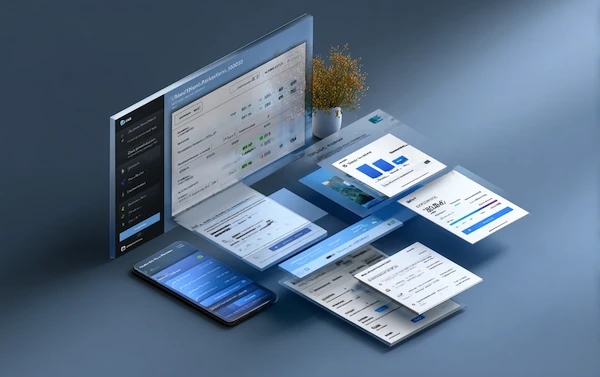Coming Up
What is Automated Reconciliation?
Automated reconciliation is a process that uses software to automatically compare and match financial transactions across different data sources, such as bank statements, internal accounting systems, and other financial records. This process aims to ensure the accuracy and consistency of financial data, significantly reducing the manual effort involved in traditional reconciliation methods. Automated reconciliation software typically includes features such as transaction matching, data validation, and exception handling, which alert users to discrepancies that require further investigation.
Why is Automated Reconciliation Important?
Automated reconciliation is crucial for several reasons:
- Efficiency: It significantly reduces the time required to reconcile accounts, allowing businesses to close their books faster.
- Accuracy: By minimizing human intervention, automated reconciliation decreases the likelihood of errors, ensuring more reliable financial statements.
- Compliance: Automated systems help maintain compliance with regulatory standards by providing accurate and timely financial data.
- Cost Savings: Reducing the need for manual reconciliation tasks saves labor costs and allows finance teams to focus on more strategic activities.
What are the Benefits of Automated Reconciliation?
Automated reconciliation offers numerous benefits:
- Time Savings: Automation speeds up the reconciliation process, often reducing the time required from hours or days to just minutes.
- Error Reduction: Automated systems apply predefined rules to data, significantly lowering the risk of manual errors and improving the accuracy of financial records.
- Improved Audit Trails: Every step of the automated process is recorded, making it easier to trace and audit financial transactions.
- Scalability: Automated reconciliation can handle increasing transaction volumes as a business grows, ensuring that the reconciliation process remains efficient and effective.
What are the Challenges of Manual Reconciliation?
Manual reconciliation poses several challenges:
- Disparate Data: Handling data from multiple sources can be time-consuming and error-prone.
- Timing Delays: Differences in the timing of transactions appearing in internal records versus bank statements can cause discrepancies.
- Manual Errors: Human errors are common in manual processes, leading to inaccuracies in financial records.
- Resource Intensive: Manual reconciliation requires significant time and labor, diverting resources from other important tasks.
How Does Automated Reconciliation Work?
The automated reconciliation process typically involves the following steps:
- Data Input: The system collects data from various sources such as bank statements, general ledgers, and other financial records.
- Comparison: The software compares transactions across these data sources to identify matches and discrepancies.
- Exception Handling: Any unmatched transactions or discrepancies are flagged for review. The system may suggest potential matches or alert users to issues that need manual intervention.
- Resolution: Users investigate and resolve flagged items, updating records as necessary. Over time, the system can learn from these resolutions to handle similar exceptions automatically in the future.
What Are the Types of Automated Reconciliation?
Automated reconciliation can be applied to various types of financial records:
- Bank Reconciliation: Matching bank statements with internal cash records.
- Credit Card Reconciliation: Comparing credit card transactions with internal records.
- Balance Sheet Reconciliation: Ensuring that balances in the general ledger match supporting documents.
- Intercompany Reconciliation: Aligning transactions between subsidiaries of a parent company.
What to Look for in an Automated Reconciliation Tool?
When selecting an automated reconciliation tool, consider the following factors:
- Functionality: Ensure the tool offers comprehensive reconciliation capabilities that meet your business needs.
- Integration: The software should integrate seamlessly with your existing financial systems.
- User-Friendliness: The tool should be easy to use and require minimal training.
- Scalability: It should accommodate growing transaction volumes and complexity.
- Security: Robust security features are essential to protect sensitive financial data.
- Vendor Support: Choose a provider with a strong reputation and excellent customer support.
How to Get Started with Automated Reconciliation Tools?
To implement automated reconciliation in your organization:
- Assess Needs: Identify the specific reconciliation processes that need automation.
- Select Software: Choose a reconciliation tool that fits your requirements and integrates with your financial systems.
- Configure Settings: Set up the software according to your business rules and processes.
- Train Staff: Provide training to your finance team to ensure they can use the tool effectively.
- Monitor Performance: Continuously review the performance of the automated reconciliation process and make adjustments as needed.
How Solvexia Helps with Automated Reconciliation
Solvexia offers a robust automated reconciliation solution that streamlines financial processes and enhances data accuracy. Key features of Solvexia's platform include:
- Data Integration: Connects with various financial systems to gather data for reconciliation.
- Transaction Matching: Automatically matches transactions and identifies discrepancies.
- Audit Trails: Maintains detailed records of all reconciliation activities for easy auditing.
- User-Friendly Interface: Simplifies the setup and management of reconciliation workflows with drag-and-drop functionality.
- Scalability: Handles increasing transaction volumes and supports business growth.
To get started with automated reconciliation, request a demo today!
.svg)































